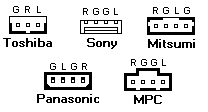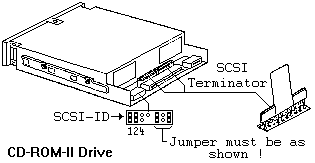|
Boot from CDROM? DOS Configuration Modifying W95/98 Install Bootfloppy Guide Rail Dimensions (convert the cheap AT rails!) OS/2 Configuration Limits of IBMCDROM Sound Without a Sound Card? CD Rom Audio Connector
Personal Preferences For 85s/95s
Boot from CDROM Many have tried. They all failed. I have tried with my NT 4 CD on my 95A off of a FW. Setup, Start Sequence claims there is no bootable media on the CD. From Bob Eager
So much spoofing is required in the BIOS that I doubt it can be
made to work. Shame...
Installing IBMCDROM.SYS From Peter Assumed, you installed an IBM SCSI-Adapter or used the one in your machine (card or onboard) to connect a SCSI CD-ROM drive to it. The adapter is recognized in the setup and so is the CD-ROM drive. But you cannot access it. What's wrong ? Do the following: get the SCSI CD-ROM Driver Disk
SCSICDRM.EXE,
extract it to a 720K / 3.5" disk run the UINSTALL-program from the disk
to install the device-driver IBMCDROM.SYS. Use a Text-Editor to add /i
in your CONFIG.SYS at the end of the line with the IBMCDROM.SYS If you
have a CD-ROM (like some NEC) and it refuses to work even after adding
the /i try to add a /P:2 as well to enable the read seek command on this
unit too. (Thanks White Box !) restart
the system
DOS Configuration Examples Sample CD-ROM DOS Configuration (one Drive)
Sample CD-ROM DOS Configuration (two Drives)
Parameters that effect the DOS - MSCDEX.EXE operation.
W95/W98 Install Bootfloppy Hack Very simple- You need to put IBMCDROM.SYS and ASPI4B.SYS on the install floppy. Add the blue text to the appropriate files. This assumes that you have one CD ROM drive as D: and one hard drive as C: I advise you to put W95's EDIT onto your bootfloppy. When you sit there with "Cannot continue, returning to DOS" you will understand why. My personal preference when infecting a PS/2 with 95 is to put the entire Win95 directoy on the hard drive. Then if you somehow mess up the SCSI adapter settings under Device Mangler, you can still get to the CAB files and reinstall things. Autoexec.bat :
@ECHO OFF
Config.sys:
[MCA]
Cannot Continue Error
OS/2 Configuration Example Sample CD-ROM OS/2 Configuration (one Drive)
Sample CD-ROM OS/2 Configuration (two Drives)
Parameters that effect the OS/2 - CD-ROM operation .
Limits of IBM CDROM Drivers What if IBM CD Rom drivers do not work? Err ... the ASPI4B driver was *intended* to be used with the ASPICD.SYS ! It simulates the ASPI-layer, which is present on "ordinary" Adaptecs after loading the ASPI4DOS.SYS (on 154x / 164x cards) and the ASPICD-driver is the physical device layer to which MSCDEX later assigns a drive letter to. The IBMCDROM.SYS is worthless in this case - it was intended as a stand-alone device driver *without* any ASPI-compliant manager layer between the hardware (CD-drive) and the software (MSCDEX). Experience showed, that the combination of ASPI4B + ASPICD often enables "non-working" drives ... but is not neccessary on more modern drives. I use a flea-circus of various CD-drives (few are "manufactured for IBM") and use them for Win95-installation for example. And I only have the IBMCDROM.SYS with the additional parameters in the CONFIG.SYS (plus the MSCDEX in the AUTOEXEC of course) - and have no problems. (Ed. My XM3101BME has IBM stickers and Part #s all over it. Hated IBMCDROM.SYS. CDR101 results. Used the Aspi4b driver. It works now. Funny, as it had been working well with the IBM driver in another machine...) May well be that it does not work with some older releases of the XM3101
- but the first series IBM CD-ROM II were XM3101 as well ... guess my 77i
is currently working with one ... must check.
ASPI4B.SYS vs. ASPIIBM.SYS From Peter As the documents ASPI4B.TXT and ASPIIBM.TXT already explain: - ASPI4B.SYS is a Tool from Adaptec for IBM to transfer "a sort of" ASPI-Manager functionality to the "Spock-like" IBM MCA SCSI Adapter along with the functions of the INT4Bh interface that these adapters normally use. - ASPIIBM.SYS is from Corel SCSI ... and does the same with a lot more parameters. Both were originally designed to enable for example SCSI scanners to work with the IBM adapters and using most of the ASPI-based software. My "normal condition" with the Non-IBM CD-ROM drives at the times before the revised IBMCDROM.SYS appeared (and before Win95 made the whole thing a bad joke) was running a CD-ROM. CONFIG.SYS contained the two lines
AUTOEXEC.BAT
ASPIIBM.SYS is the Aspi manager layer, ASPICD.SYS is the
physical interface device driver using the Aspi command set, MSCDEX is
the operation system device driver that routes a drive letter to the device
named after /D ...
Sound Without a Sound Card From Peter >I notice my CDrom drive has a line output in rear. Why cant I attach an audio plug,and run it to an amp. Sure can - no problem. Did that with my first CD-ROM drive when I had no soundcard in my old IBM AT back in 1987 or so. The connector has L-G-R (or L-G-G-R or whatwever) and is straight analog audio output. The one at the front (if present) is for low-impedance headphones (200 - 1000 Ohms). The rear port is for hi-impedance amplifiers. > Question is-is audio there when used in music mode as well as in the program decode mode? The audio signal is only present, when there is an audio-CD running
in the drive. The "audio" derived from data CDs (e.g. WAV or such) needs
a soundcard to convert the digital data packets back to analog signals.
CD Rom Audio Connector 
|
